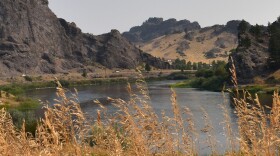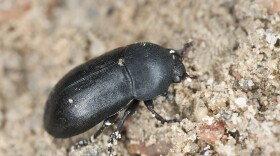
Field Notes
Wed. at 3:53 p.m., Sat. at 11:53 a.m.
Nature notes and inquiry from the Montana Natural History Center.
-
Fireweed’s vibrant flowers provide sweet nectar to native bees, flies, butterflies, and even honeybees, if their hive is nearby.
-
Oak gall ink was the most popular ink in Europe from the Middle Ages to the 19th century. The Book of Kells from A.D. 800, the Magna Carta, and the Declaration of Independence were all written in gall ink.
-
My eyes slowly followed the tree down to the base when I saw that my dog was carefully pulling the berries right off the branches and swallowing them down.
-
This amazing place has seen it all, from a giant sea to volcanoes and glaciers to today’s semi-arid desert.
-
Clueless as to what this was, I relied on a phone app for identification. Curlycup gumweed? Who came up with that creative name?
-
On the suggestion of an experienced birder, I bought a wire wreath and stuffed it with unshelled peanuts. The magpies spent hours skirmishing with each other to grab a peanut. I reveled in the mayhem.
-
There were tulip poplars, also known as yellow poplars or tulip trees. No tulip maples. I’d thought I’d seen the real thing in Washington, DC. No such beauties adorned my backyard.
-
Throughout history, people have been captivated by owls. There are 260 species of owls across the planet. They can be found on every continent except Antarctica.
-
I’ve always been fascinated by ruffed grouse. For such a small, skittish-seeming bird, they have a hugely outsized presence in the soundscape of the forest.
-
It’s easy to see how the nighthawks’ idiosyncrasies make them a crowd favorite, but what I love most about them are the cherished memories they resurrect.
-
A lone Sandhill Crane stood at the edge of the marsh feeding, its bill dipping repeatedly through the mud with a series of rapid, steady bursts reminiscent of a sewing machine’s insistent motion.
-
Earthworms use their entire body to breathe. Burrowed deep in the ground — slow moving, slow metabolizing — their long frames tighten and relax and pull the air they need from soil.
-
They looked like bulging stockings decorating a mantle at Christmastime. They were certainly gifts of a sort for our winter-weary senses. These were the unique nests of Bullock's Orioles.
-
In the natural world, how to persist—how, even, to improve—in the face of limits and uncertainty can be a punishing question.
-
As I drove home from Missoula, I was alarmed to see wildfire smoke across the freeway from my house in Frenchtown. Even more concerning was the convoy of pickups pulling stock trailers.
-
We have three species of garter snakes in Montana. The snake couple I saw were the terrestrial species, Thamnophis elegans, who can lack the colorful markings of the other two.
-
In late 2020 I’m spending mornings masked, working in a lab in the University of Montana Zoological Museum. The museum houses research collections of natural artifacts like skins and skeletons. But behind the scenes museum staff tend a single living collection: a colony of dermestid beetles, the meticulous scavengers that scour flesh from bones before a skeleton can be installed in the museum.
-
Why are they so feared and misunderstood? If a bird popularity contest were held, Turkey Vultures would not fare very well. A spooky bird contest, on the other hand? Dead winner.
-
First one, buzzing and bumping into the living room window, who was soon joined by a few sisters. Within an hour, there were more than 40 sinisterly striped yellow jackets (Vespula alascensis) zooming from one window to another in pursuit of light, and I was outnumbered.
-
As I watched Rob Domenech, executive director of the Raptor View Research Institute, and his research biologist Brian Busby carefully load the three chicks onto the lift, and heard Harriet’s chirps of protest from above, I considered the importance of this work.
-
At Lee Metcalf National Wildlife Refuge, I saw an Osprey dive into the deepest section of white water and emerge with nothing to show for its effort, and then retreat to a cottonwood branch to watch for another opportunity in the dark, boiling water.
-
A small spot of orange in the middle of the trail caught my eye. It wasn't a leaf or a berry; it was tiny and moving! As I neared the curious sight, I discovered it was a fuzzy caterpillar.






















